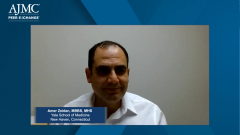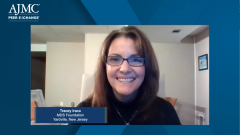
Practical Considerations for the Use of HMAs in Higher-Risk MDS
Shared insight on the historical and current use of hypomethylating agents in patients with myelodysplastic syndromes.
Episodes in this series

Transcript:
Bruce Feinberg, DO: As we get into HMAs [hypomethylating agents], we historically have 2 drugs that are both administered IV [intravenously] with very difficult schedules of administration. Let’s start with that, and then we’ll work in the newer agent. Start with the historical background of HMAs and their promise, but also the difficulties that often led to them being used suboptimally.
Amer Zeidan, MBBS, MHS: HMAs were used back in the 1970s. They were used at much higher doses than now, so they were more like a cytotoxic chemotherapy. They basically were abandoned in terms of using them in other cancers until they made a resurgence, when we understood their epigenetic impact better—what we call the hypomethylation impact of those drugs. Then studies showed that they can actually lead to clinical responses in patients. They can lead to transfusion independence, complete responses in some patients, reduction of the blast count, improvement in quality of life, and even improvement in overall survival, which has been shown only with azacitidine. One of the main developments in MDS [myelodysplastic syndromes] has been the approval of both of those drugs, azacitidine and decitabine, but most recently the oral version of decitabine as well. Those drugs are a mainstay of treatment of MDS, especially in the high-risk patient population where they’re the standard of care option as a frontline treatment.
Bruce Feinberg, DO: Ryan, have you been seeing any transition from one agent to another over your years of working with these patients? Did you see a migration in preference based on either emerging data, administration schedules, or perceived toxicity, and then movement to an alternative that doesn’t have that administration schedule?
Ryan Haumschild, PharmD, MS, MBA: Yes. We’ve seen patients not enjoying HMAs, even though they’ve been around for a while. Do we see a transition? Yes. I’d say patients are trying to get away from those hypomethylating agents if possible. Obviously, azacitidine and decitabine have been some of the choices that our providers have made. But as we incorporate that patient more, we’re realizing some patients want an oral option. They don’t want to have to come in for an IV infusion that’s really inconvenient. Once they realize that, some may say, “I’d just rather get my transfusions and not deal with this.”
We’re also seeing a segment patient population that’s more of those high-risk patients who are saying, “I can’t really make it through 4 cycles. I’m an older patient. There are a lot of adverse effects. Is there anything else that’s more tolerable that I can take on?” That’s where we’re starting to look at these other agents that give better responses to patients, have a little more of a tolerable adverse effect profile, and can be dose titrated a bit more easily, and potentially even taken at home as an oral agent, like lenalidomide. That’s the treatment progression that we’re starting to see.
Bruce Feinberg, DO: It’s interesting you say that. Amer and Ryan, you can both weigh in, but I must have had at least a half dozen family, friends, relatives diagnosed with AML [acute myeloid leukemia] with likely preceding AMS who got an HMA and went into a complete remission for a period of a year or more. And it almost seems as if because it was an AML diagnosis, there was the willingness to accept whatever in terms of toxicity. It gets patients to just go for it. That willingness isn’t there when they don’t perceive the severity of their situation. This is strictly anecdotal, but I’m curious. Amer, do you observe something like that as well?
Amer Zeidan, MBBS, MHS: Yes. But it depends on what it is within MDS that you’re dealing with. This is one of the interesting aspects about MDS. Because once you say acute myeloid leukemia, everybody knows this is very serious, this is life-threatening, and it needs immediate treatment. When you talk about MDS, you have that spectrum of reactions. If you have 18% or 19% blasts in your bone marrow and your blood counts are very low and you have complex karyotype, that’s much worse than some subtypes of AML. It’s important to make sure that the patient understands that while this isn’t acute myeloid leukemia—this might be a good juncture to mention that patients are terrified of the term acute myeloid leukemia and tend to focus on it a lot—most patients with MDS unfortunately die from MDS. They don’t die from progression to acute leukemia, they die from complications of the bone marrow failure itself. One of the goals of therapy is to prevent going to AML. The main goal is to reduce the cytopenias and reduce the complications that arise from cytopenias.
Bruce Feinberg, DO: That’s a very interesting point. Tracey, do you think your perception is similar? I don’t know if you surveyed caregivers, but in regard to community hematologists, is their perception that patients die from AML? Or that they die from another cause, and because they’ve had MDS, like CLL [chronic lymphocytic leukemia], they just have it for their aging life? Or do they perceive that they die from MDS, but not from the AML aspect of its progression? More from just chronic cytopenias, infections, refractory to transfusions, etc?
Tracey Iraca: It’s definitely the fear of progressing to AML. The progression is everyone’s worst nightmare. To your point, as soon as they’ve been told, “OK, you’ve now progressed to AML,” they’re willing to try any treatment most times because they know they don’t have a lot of options because time isn’t on their side anymore. They’re willing to put up with the adverse effects or the burden and transportation or all of the things that come along with that treatment cycle. There definitely isn’t as much conversation around the fear of dying from MDS. To Amer’s point, it’s because of that spectrum. Because for most people, if they’re diagnosed with high-risk MDS, then they get it a lot more than people who have been diagnosed at low risk, who then gradually over many years have gotten to the high-risk point.
Bruce Feinberg, DO: Ryan, you’re nodding your head.
Ryan Haumschild, PharmD, MS, MBA: Yes. I agree with everything they said. When it’s AML, it’s trauma. “What do I have to do? I’ll do anything.” But if they’re getting by on ESAs [erythropoiesis-stimulating agents] or blood transfusions, they don’t have motivation and they’re not going to be successful. We’ve learned so much that persistence with these agents is key to great results. If they’re not persistent and they’re not staying here and they don’t make it through those 4 cycles, you’re not going to see that therapeutic effect that we’re looking for, and that’s where patients connect the dots more. Sometimes our providers are wondering, “How do I better tell the story so someone takes this seriously and persists on this medication for a good result?” That’s the difference that you were teasing out, Bruce.
Bruce Feinberg, DO: Yes. And at least with some of the work I’ve done and real-world evidence, it’s not just the patient. It’s the providers who aren’t willing to go that last mile with the therapy. They start to back off because they just don’t want to have to deal with that toxicity or the fear that they’re going to have an induced shortened life expectancy because they’re pushing it too hard. But that was the old days. I’m old. That was what we did from the mid-1980s through the early 2000s. It was all you had. Before you started thinking about doing less harm, it was all about push, push, push.
Transcript edited for clarity.
Newsletter
Stay ahead of policy, cost, and value—subscribe to AJMC for expert insights at the intersection of clinical care and health economics.
































































